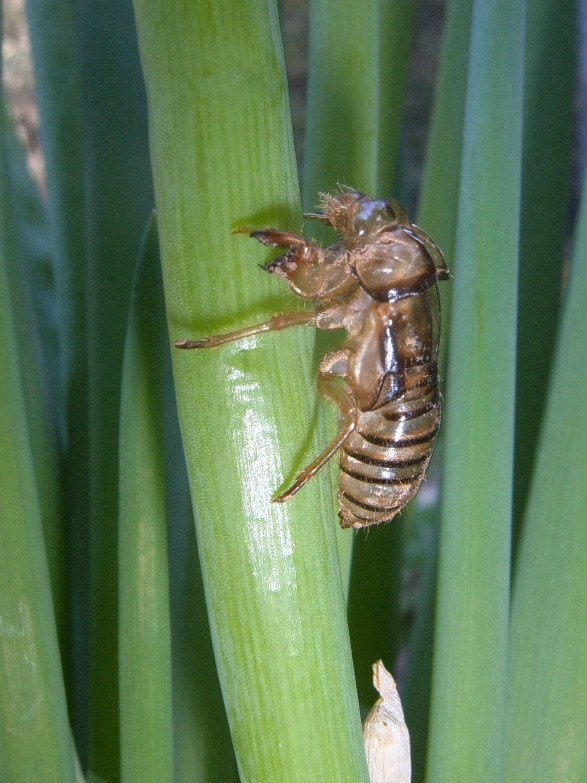Ever since the last part of April I have been hearing this soft, high-pitched snapping sound coming from forest edges and isolated shrubs and trees. Actually, the sound could be described a bit like “ti ti ti ti ti” or “nip nip nip nip nip.” There might be one “nip” per second or six per second depending on the temperature. On a given morning, as the temperature rises the snapping sound is more frequent. This odd sound is made by a cicada. Now, if you and I had decided to go out on a cicada hunt, we might be able to hear one or two but to see or find one could be a bit tricky.
One way to snoop out a cicada is to stand still somewhere on a warm day and track down the sound, taking a step or two toward it each time it sounds off and while it is doing so. They have very sensitive hearing, so if we step on dry twigs or grass, they may stop “calling” for a while. The most difficult part of this whole tracking venture is pinpointing the sound once you get within 10 feet or so. It seems like the sound is coming from everywhere. I would say cicadas are ventriloquists.
Only rarely have I ever spotted one, usually at or near the tip of a low tree branch. To help the search along I would try a little trick.
If we determine that a cicada is in a certain bush or on a particular low limb of a tree, I would attempt to jar the creature so that it would move and hence reveal its hiding place. If it was in a bush, I would sidekick the base or trunk while at the same time watching for any fast getaway. If it is a warm day, the creature will likely fly off with a click and a buzz of wings to another perch. However, if it hadn’t yet warmed up enough to fly, it might drop to the ground and we could quickly close in and cover it with our hands until it could be grasped in the fingers. Then we would get a good face-to-face meeting with the evasive cicada, then let it go.
If the cicada snapping sound is coming from a branch, we could strike the branch sharply with a stick and the cicada would fly away or fall to the ground. Either kind of getaway would make it difficult for predators to catch.
They are quite strong but they don’t bite, as if they had jaws, but they do have a piercing mouth part that can give a bit of a jab if permitted. On a branch, the cicada is really hard to spot. The one we have in our midst now has a dark body, which looks like a branch, and transparent wings, making it quite invisible.
It seems that there are two species of cicada in this area. The dark-coloured, one-inch species occurs in May, and the larger one with brown coloring at the base of the wings can be 1.25 inches long. The latter makes a long buzzing call somewhat like the sound that comes from transmission lines on a frosty or foggy day. They are a little easier to locate because they often buzz, when it’s hot, continually for a minute’s duration.
The call of a cicada isn’t very often heard. By that, I mean people hear it but they don’t consciously listen to it. That’s the way it is with a lot of sounds out there and, digressing, I will say it’s the way, unfortunately, with a lot of human communication.
Much of the life of a cicada is spent underground. The number of years depends on the species. Many people are familiar with the 17-year “locust” which is a misnomer. (A locust is in the grasshopper clan while the cicada is in a separate group.) Both the 13-year and 17-year periodical cicadas emerge in very large numbers on those years. The Annual cicada spends two to five years underground feeding on juices from roots emerging every year.
Where cicadas are abundant, tree fruit farmers see some twig damage done by the female cicada. It lays its eggs in a slit it makes in the bark of tender twigs, thus making breakage points. On hatching, the young make their way to the ground to live out the rest of their lives “with the underground”. On maturing, they make their way to the surface, shed their “mining suit” and fly about to propagate the species.
By the time you read this, there may still be some “nipping” cicadas; however, you may start to hear the larger buzzing type. Most might be higher than you can possibly spot or catch; however, they do sound off from low bushes and branches. So, on your cicada snoop, if you don’t at first succeed, try again!
Ed McMackin is a biologist by profession but a naturalist and hiker by nature. He can be reached at 250-866-5747.
